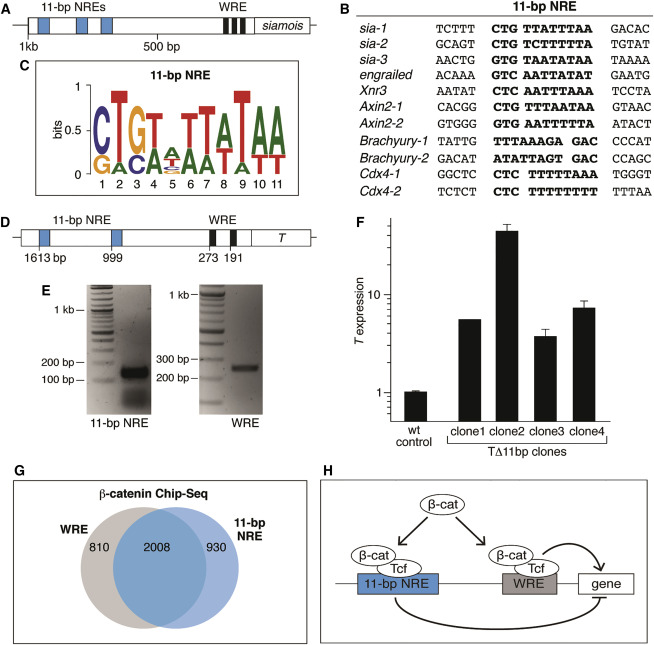XB-IMG-158333
Xenbase Image ID: 158333

|
Figure 4
11-bp NREs Regulate Brachyury, T, in mESCs
(A) The siamois promoter contains three 11-bp NREs, including the distal element characterized so far (blue). See also Figure S3A.
(B) 11-bp NREs found in the promoters of siamois, engrailed, Xnr3, Brachyury, Axin2, and Cdx4.
(C) Position frequency matrix built using the identified 11-bp NREs in (B). See also Figures S3B and S3C.
(D) T promoter in mESC contains two WREs and two predicted 11-bp NREs.
(E) ChIP using β-catenin antibody, followed by PCR amplification from 11-bp NRE (left) and WRE region (right) in the T promoter. The result was reproducible across two biological replicates. To ensure that immunoprecipitation of the 11-bp NRE fragments was not confounded by the WRE, we sonicated the chromatin to 100–300 bp and performed PCR validation.
(F) CRISPR/Cas9 was used to target genomic deletion of the 11-bp NREs in the T promoter. Four mESC clones carrying genomic deletion of 11-bp NREs (TΔ11bp) were analyzed with qRT-PCR for T expression. Error bars indicate SD from three biological replicates.
(G) Analysis of β-catenin ChIP-seq on HEK293T cells. We examined 1-kb β-catenin peak regions for the presence of the 11-bp NRE and WRE. Of the 4,484 total peaks from the β-catenin ChIP-seq, 3,748 contain the 11-bp NRE and/or WRE motifs. Of these 3,748 peaks, 2,008 contain both motifs. See also Figure S4.
(H) Our findings suggest that signal in the Wnt pathway does not only activate target genes through WRE, but also tunes expression of the gene through a suppressive 11-bp NRE. Further, our findings also suggest that β-catenin mediates this coupling. Image published in: Kim K et al. (2017) Copyright © 2017. Image reproduced with permission of the Publisher, Elsevier B. V. Larger Image Printer Friendly View |
